AN AGRICULTURAL BEGINNING
Nestled on the right-hand side northbound Fairfax County Parkway VA-286 is the Historical Highway Marker E-98 entitled “Fairfax Nike Missile Site.” This placard announces the former Fairfax location of a surface-to-air Nike missile site and the related command post nearby during the Cold War.
From the Historical Highway Marker website the plaque E-98 states: “During the Cold War a ring of Nike anti-aircraft missile sites defended the nation’s capital, reminiscent of the perimeter of forts that protected it during the Civil War. Just east of here was located the launch control equipment for one of the three Nike complexes in Fairfax County. To the west stood the missiles, poised on above-ground launchers. The U.S. Army (1954-1959) and the Army National Guard (1959-1963) operated this battery. Built to oppose Soviet air attack, this complex and those in Great Falls and Lorton were three of thirteen Nike sites that surrounded Washington and Baltimore (Department of Historic Resources, 1994.)
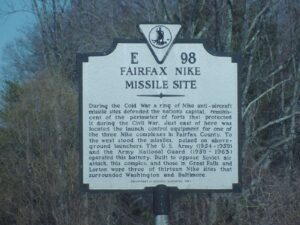
Taken: February 16, 2006
Caption: Fairfax Nike Missile Site Marker
Submitted: February 16, 2006, by J. J. Prats of Powell, Ohio.
Database Locator Identification Number: p228
Yet the history of the “Fairfax Nike Missile Site” is not as simple as the Highway Marker would make it seem. The physical land, its inhabitants, and the interaction with those who live, travel, work on and with the land have changed overtime. Often the usage or increase of population was due to the waxing and waning of war and peacetime. This project will discuss the broad lifecycle of the land and its usage by the people who live in Fairfax County.
Prior to building the Fairfax Nike Missile site, the inhabited portion of the land was mostly forested, with patches of agriculture. Local human interaction with the land was largely farming, both in crops and animal husbandry.
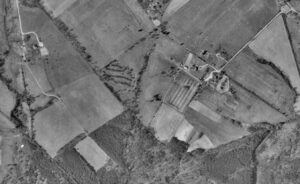
Using the Historical Imagery Viewer and looking at imagery from 1953, it’s evident the land to be utilized later as the Fairfax Nike Missile site, was at this time was used for mostly agricultural activity. The image embedded above has several well kept farms in the Fairfax Pope’s Head region. Per the Burke Historical Society tobacco was an important crop in early Virginia, but as the Caribbean began to produce it, it’s farming in Northern Virginia greatly decreased, “in the 1860 agricultural census only two citizens in Fairfax County grew tobacco, while the majority raised wheat, oats, rye, Irish potatoes, Indian corn, and hay and raised cattle, milk cows, sheep, swine, horses, and oxen. By 1900, Fairfax County was ranked the number 1 dairy county; and number 3 in orchard crops, peaches and apples, in the Commonwealth of Virginia” (Burke Historical Society, 2020).
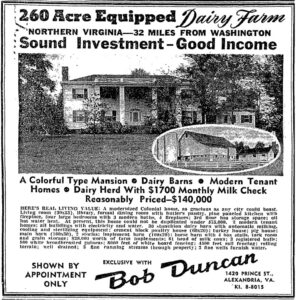
FAIRFAX NIKE MISSILE SITE PRODUCTION
Following World War II and the successful detonation and use of the atomic bomb by the United States against Japan, the Soviet Union sought its own weapon of equal or greater caliber. This spurred a bipolar escalation of gathering war materiel between the United States and the Soviet Union known as the Cold War. Thus, with increasing apprehension in 1953 after the Soviet Union successfully tested a hydrogen bomb and the fear that they could deliver this onto United States soil using an airplane, the idea for increased air defense around the Washington DC was broached. The Fairfax Nike Missile Site was one site of a ring of surface-to-air missile sites that encircled the Nations capitol.
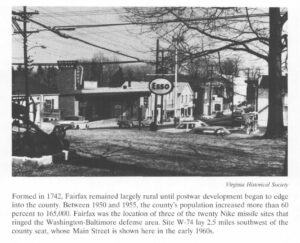
Fear of a nuclear attack had already permeated some of the children in the area with local Irma Clifton writing, “We kids were already preparing for an air attack in school by having drills where we would get under our desk and cover our heads then wait for the all clear siren, so we were somewhat familiar with a kids-eye view of national security” (Clifton, 2010). On a national scale children were being taught the realities of potential nuclear warfare in the homeland with educational films such as the 1951 “Duck and Cover.”
This film is part of public domain.
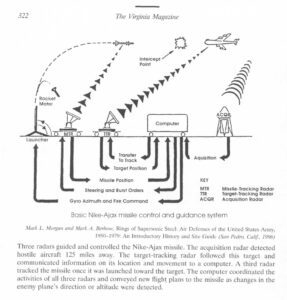
Mark L. Morgan and Mark A. Berhow, Rings of Supersonic Steel: Air Defenses of the A United States Army, 1950-1979: An Introductory History and Site Guide (San Pedro, Calif. 1996)
From the Virginia Magazine of History and Biography; Richmond Vol. 105, Iss. 3: “The Nike siting process in Fairfax County apparently encountered few obstacles Ample locations throughout the region met the military’s technical requirements…The negotiations for the purchase of the land apparently proceeded smoothly and rapidly because in April 1954, before the transfer of ownership was completed, project maps drawn up by the Corps of Engineers precisely delineated both the required tracts, and the corps had advertised for construction bids, even though the sale was not formally consummated for another two months.” (Bright, 1997). Although the process of acquiring land went comparatively easy, the hilly terrain and amount of trees made preparing the site difficult.
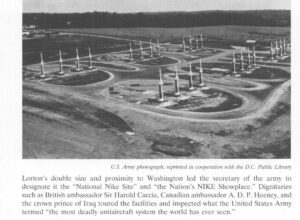
US Army Photograph
Once operational from 1954-1959 the United States Army staffed the Fairfax Nike Missile Site. “On a day-to-day basis, troops at each Fairfax County battery ran diagnostic checks on the radars, missile electronics, and engines. Given the relative complexity of the equipment and the constant operation of some of it, there was much to do. The assignment and maintenance of one hundred men per facility necessitated considerable routine administrative work as well. Although most tasks were tedious, others, such as fueling the Nike-Ajax and replacing and testing missile parts and warheads, posed potential danger” (Bright, 1997). They also hosted newspapermen, foreign dignitaries, and even school children in order to inform the public on the work they were doing.
In 1959 the active duty component relinquished command to the Virginia National Guard control. They retained control until 1963 when the site closed as a missile site for good.
TODAY
Nowadays the former Fairfax Nike Missile is used for several purposes. The former command center is used by the Fairfax County as a Maintenance & Storm water Facility, the missile magazines have been transformed into Pope’s Head Park, and the Fairfax Police Department uses a portion of the land for their own purposes. The once forest and farmland that was molded by the US Army into a functional weapons site has evolved towards being used by citizens as homes, parks, and municipal purposes.

“Although the Cold War had many profound effects on Fairfax County-including spurring a population explosion as families moved there to be near the Pentagon and the ancillary businesses that sprang up around it3-to Mark Turner, Ida Money, and other citizens of the time, such missiles were the most obvious and tangible manifestation of the postwar tensions between the United States and the Soviet Union.”
According to Dr. Donald M. Sweig, a county historian: “Fueled by vast increases in the size and scope of the federal government, and facilitated by ever more and better transportation — especially new roads and bridges across the Potomac — Fairfax County changed from a rural agricultural, to predominantly residential, and finally to an increasingly complex and populous commercial and residential community” (Dr. Sweig, 1995).
The international influences of World War II, the cold war, the nuclear age, and finally relative peacetime have shaped, reshaped, and transformed the land, the usage, and the people of Fairfax Virginia. The former Fairfax Nike Missile Site is not a memory un-tethered from context, rather it’s evolution mirrors it’s population. What was once forest and farmland was transformed into a national defense site to counter nuclear war then remade during peacetime to be for recreation and police training. Who knows what the next transformation will hold for this portion of Fairfax County.
References:
Clifton, Irma. “Nike Missile Site – Home – Workhouse Arts Center.” https://www.workhousearts.org/wp-content/uploads/2019/11/NIKE-Missile-Site.pdf. Workhouse Arts, December 8, 2010. https://www.workhousearts.org/wp-content/uploads/2019/11/NIKE-Missile-Site.pdf.
zed4Xfr. “Changing Agriculture of the 19th Century in Fairfax County, Virginia.” Burke Historical Society, October 7, 2020. https://burkehistoricalsociety.org/changing-agriculture-of-the-19th-century-in-fairfax-county-virginia/.
“Fairfax County Historical Imagery Viewer.” Fairfax County Virginia. Fairfax County Virginia, 1953. https://www.fairfaxcounty.gov/maps/aerial-photography.
Bright, Christopher John. 1997. Nike defends washington: Antiaircraft missiles in fairfax county, virginia, during the cold war, 1954-1974. The Virginia Magazine of History and Biography 105, (3) (Summer): 317-346, http://mutex.gmu.edu/login?url=https://www.proquest.com/scholarly-journals/nike-defends-washington-antiaircraft-missiles/docview/195914395/se-2?accountid=14541 (accessed December 7, 2021).
Anderson, Steve. “Popes Head Park, Fairfax Station, VA 22039, USA.” Https://Www.businessyab.com, Https://Www.businessyab.com, 7 Dec. 2021, https://www.businessyab.com/explore/united_states/virginia/fairfax_county/springfield/fairfax_station/popes_head_park.html.
Sweig, Donald M. “A Brief History of Fairfax County by Donald M. Sweig, PH.D …” A brief history of Fairfax County, February 1995. https://res-3.cloudinary.com/simpleview/image/upload/v1/clients/fairfax/fc_history_c4736378-a5e4-4799-bb05-991f9d4bbbdf.pdf.